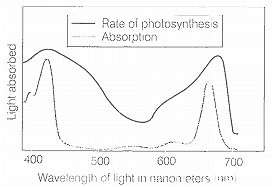52. In the figure given below, the black line (upper) indicates action spectrum for photosynthesis and the lighter line (lower) indicates the absorption spectrum of chlorophyll-a, answer the following.

(a) What does the action spectrum indicate? How can we plot an action spectrum? Explain with an example
(b) How can we derive an absorption spectrum for any substance?
(c) If chlorophyll-a is responsible for light reaction of photosynthesis, why do the action spectrum and absorption spectrum not overlap?

© 2024 GoodEd Technologies Pvt. Ltd.